What is Google Advanced Image Search? How to Use, Tips & Tricks, and More
Have you ever spent a whole hour scrolling just to find the right visual as per your preference? If yes, I assure you, not anymore!
I’ve got my hands on a great feature called ‘Google Advanced Image Search,’ which helps users find their ‘the one’ visuals in just a few clicks. But, the sad part is despite being so constructive, it is yet overlooked by most of us.
So, here I am to walk you through all the required details of this feature, from what it means to how to use it to the fullest; we’ve got everything covered.
👉 Also Read: Importance of Digital Marketing
What is Google Advanced Image Search? (Quick Overview)
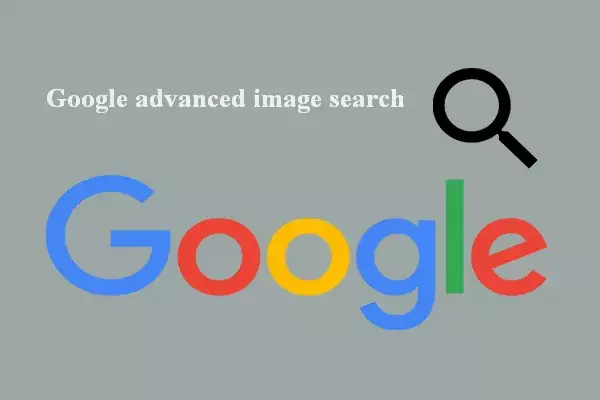
Google Advanced Image Search is a feature that allows individuals to search for images with specific filters beyond just a keyword.
For instance, if you want to search for an image with a particular word or phrase, you’ll find that filter option under Advanced Google Image Search. It’s comparatively easier to search for pictures with exact phrases, region, site, or domain, and even file type.
But most of us don’t know how to use Google Images Advanced Search wisely. Until last year, I used to scroll and look for visuals mindlessly, but then I got my hands on this feature, and my approach changed.
Also Read: What is Search Engine Positioning? How Does it Help to Rank Higher on Google?
How to Use Google Advanced Image Search?
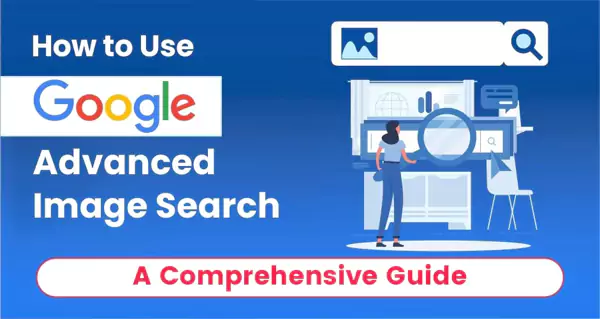
Now that you know enough about Google Advanced Image Search, let’s get straight into how to use this feature to the fullest.
- To access this feature, visit Google Images or simply search for something and go to the images option.
- Right below the search bar, you’ll find an option for ‘Tools’ – tap on that.

- Start by managing your preferences from the list.
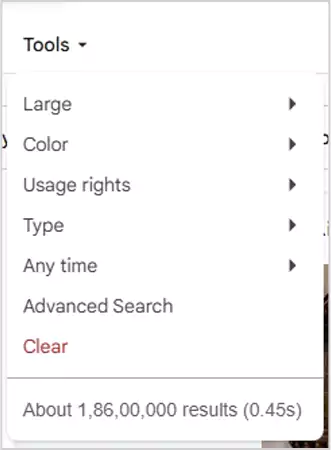
- “Large” denotes sizes; choose one according to your preference from the list.
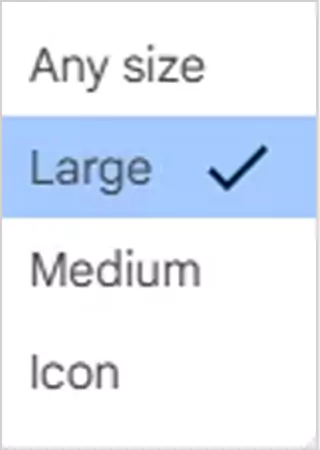
- Further, do the same for the rest of the options, and decide on one or several based on your preference.

- Manage preferences for Type and Any time, similarly.
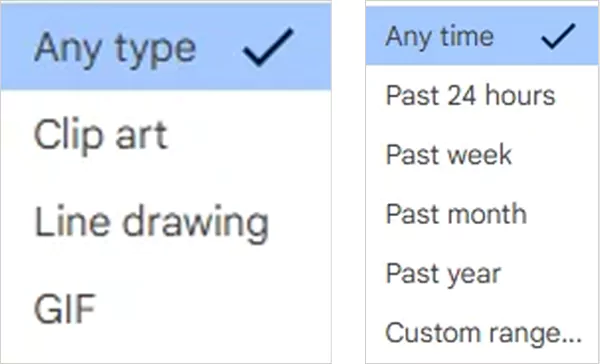
- Here you go. After marking the preferences, it’s done—you’ll have the search results ready in no time.
If marking a step-by-step preference approach sounds burdensome to you, I’ve got another workaround for this. You can simply visit Google Advanced Image Search and mark your preferences with exact phrases, filters, and keywords in one go.
Tips to Make the Most Out of Google Advanced Image Search
Here are some pro tips and tricks mentioned (expert point of view) that can help you make the best out of this feature:
- Use exact phrases for precise results, and put your keyword inside the quotations. For instance, if you want to search for Flipkart Upcoming Sale 2025, search it like this – ‘’Flipkart Upcoming Sale 2025.’’ It’ll help in getting more precise details and not just random information.
- Make the most use out of the filter options, use as many preferences as you can, and be more specific & detailed. For instance, if looking for a PNG ad campaign from the past few weeks. Set the preferences of type to PNG and the filter to the past month.
- Look for images labelled for reuse or commercial use; this will protect you from getting into legal and ethical chaos. Users often overlook this factor, but disregarding this can cost you heavily.
- Even with the advanced search results, it’s sometimes tough to identify your competition; that’s where the Google Ads spy tools wave a hello. These tools allow you to go beyond basic search and provide detailed insights on top-performing ad creatives and the ranking visuals of your competitors.
Popular Alternatives to Google Advanced Image Search
You’ve got enough information about the advanced search by image so far; here are some of the popular alternative approaches for this (just in case you’re looking forward to a second option).
Reverse Image Search
One of the popular alternatives is the reverse image search, popularly known as ‘search by image,’ where you can just upload a picture or a link, and your search results will be ready.
By this approach, you can discover the origin of a picture, locate other websites that feature the same image, and much more. This helps in cutting down the research work and hours of mindless scrolling.
Additionally, this feature helps you identify if the picture is genuine or manipulated. If genuine, you can identify the origin, and if manipulated, you can trace where else this picture is getting used and get it down.
Other Key Features of the Reverse Image Search:
- Finding Similar Images
- Identifying the Original Source
- Discovering Where an Image is Used
- Verifying Photo Authenticity
- Visual Search and E-commerce
Lenso.ai – AI-powered Reverse Image Search Tool
Lenso.ai is one of the best reverse image search tools with facial recognition. All you need to do is upload an image and check for matches across categories such as People, Duplicates, Places, Related, or Similar. You can also create free alerts for specific images and receive email notifications whenever new image results appear online. Additionally, filters by domain and keywords are available, along with sorting options such as newest/oldest or best/worst match.
Other Key Features of lenso.ai:
- AI-powered reverse image search
- Advanced facial recognition
- Vast image index
- Free alerts for new images
Google Lens App
Google Lens is an AI-powered tool that helps individuals gain deeper insights from a mere picture. For instance, if you’re looking for some clothes, a gift, or anything, you can simply put out a picture and put it on Google Lens, and it will pull out the rest of the details for you.
Besides this, you can use this tool for object identification, landmark recognition, product information, real-time translation over 10 languages, and more. On top of this, one can use this tool as their homework help and get step-by-step solutions for the problems in no time.
Other Key Features of the Google Lens App:
- QR Code and Barcode Scanning
- Find Similar Looks
- Discover Dishes
- Identify Skin Conditions
- Learn about Art
Bing Visual Search
Bing Visual Search, this one is also known as ‘search by image,’ which means that you can search an image as a query instead of a keyword, phrase, or text.
It is not an entirely AI model, but it leverages AI and computer vision to understand the content of images, providing results like similar images, related products, and relevant web pages.
Following this approach, you can analyze the image and identify objects, text, and other visual elements to understand the content briefly.
For instance, if a user uploads a picture of a specific plant, Bing Visual Search can help you identify the flower, find similar images, and potentially locate the websites where that flower is available in just a few clicks.
Other Key Features of the Bing Visual Search:
- Image Recognition
- Object Detection
- Similar Image Search
- Animal and Plant Identification
- Text Recognition (OCR)
Also Read: What is PPC in Digital Marketing? | PPC Basics That You Should Know in 2025
BONUS – The Ultimate Mantra for Ranking Boost Through Google Images
The ultimate mantra for ranking boost is quality content + Google Images + SEO + E-E-A-T approach.
You’ve got enough information about Google’s advanced image search. Now, it’s time to know about this ultimate mantra to increase organic traffic. Here’s a breakdown of how this approach helps in boosting SEO strategy performance and credibility.
Consistent Visual Branding
If you’re posting credible visuals like original charts, insightful infographics, product images, and more, Google will associate them with your domain and list your website as a credible resource. So, when any user comes across your listed visual in the advanced image search, you’ll earn a visual backlink.
Credible Sources and Context
When you embed a credible visual from a renowned source, it acts like a trust signal for the website. On top of that, clearing files, adding captions, and placing schema help in understanding the image content, so make sure to integrate that in your visuals.
Leverage Reverse Image Search
Lastly, reverse image search allows you to track where your visuals are being used, so you can see if they’re legitimate and being used in the right way. You can request attributions and earn a backlink profile.
Related Read: How to Rank on First Page of Google
Summing Up!
By now, you know this Google Advanced Image Search feature isn’t just for saving you from mindless scrolling. If you use it mindfully, you can potentially use it to earn a backlink, profile, and list your website as a credible source.
So, whether you’re a user who is tired of scrolling or a marketer who wants to rank their visuals in the images section, this feature helps all—it’s your sign to make the best use out of it.
FAQs
- Large
- Color
- Type
- Usage Rights
- File Type
- Go to Google Images
- Enter the keyword in the search bar
- Click on ‘Tools’ and mark your preference.
- Here you go, it’s done.










